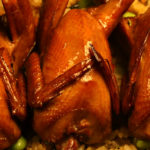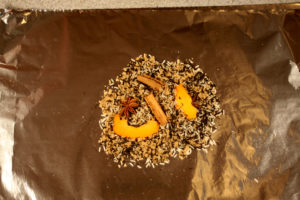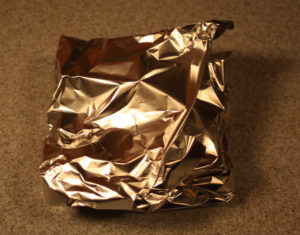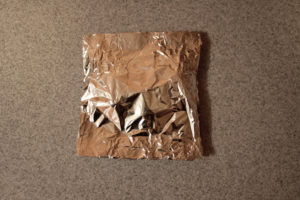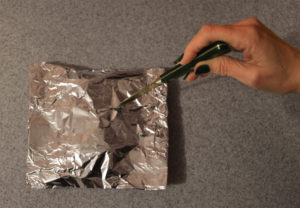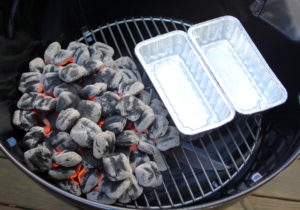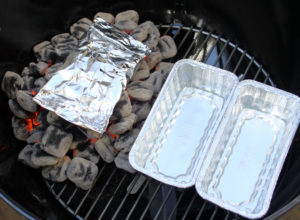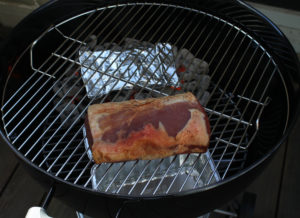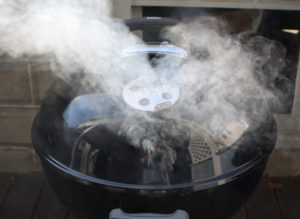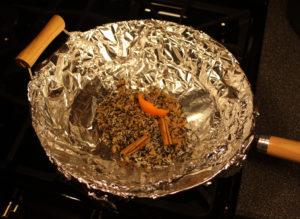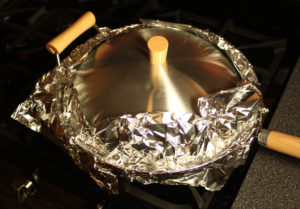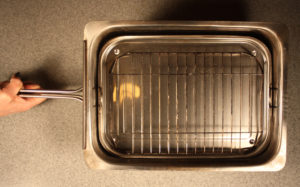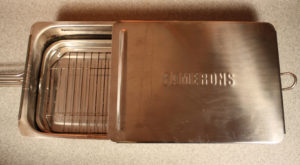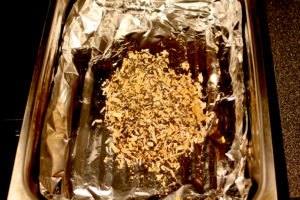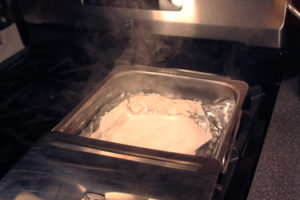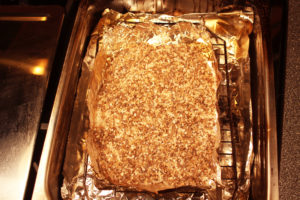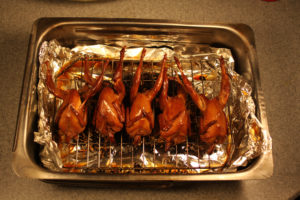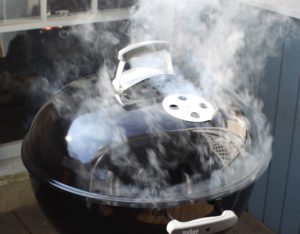 Smoking is an ancient food preservation technique prized now more for the flavors imparted by the smoke during the cooking process then the actual preservation of the food. Smoking with tea leaves is one of the earliest examples of historic tea cuisine. The iconic Tea Smoked Duck is still enjoyed today, often using the same classic techniques developed generations ago.
Smoking is an ancient food preservation technique prized now more for the flavors imparted by the smoke during the cooking process then the actual preservation of the food. Smoking with tea leaves is one of the earliest examples of historic tea cuisine. The iconic Tea Smoked Duck is still enjoyed today, often using the same classic techniques developed generations ago.
Sometimes in fact, the smoke is used only for flavor transformation, such as in tea smoked salt or cheese, or even smoked cocktails, and no cooking of the product is desired at all.
Smoking with tea leaves is not that different from classic wood chip smoking, and in fact tea leaves and wood chips work beautifully together. More often than not, blended in with the tea leaves, will be, if not wood chips, other aromatic flavor components such as spices, nut shells or zest as well as uncooked rice to moderate the burn-off of the leaves, and sugar to aid the smoke in penetrating and sticking to the item being smoked.
Larger leaf aromatic teas such as Keemun, Yunnan, Nilgiri, lychee and jasmine, work very well for smoking and you will select the best tea as well as the other aromatics according to the food being smoked.
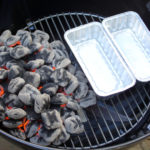 There are a variety of approaches to smoking with tea leaves such as using a commercial smoker, an outdoor gas grill with or without a smoker box, an outdoor charcoal grill, an indoor stovetop wok, hotel pan or commercial ‘smoking pan’ or even a hand held smoker like the commercial ‘Smoking Gun’ or a vaporizer. For each of these techniques, other than the smoking gun which is used solely for the flavor and aromatics, you have the option of cooking the product in parallel with smoking it. The example we’re using with the ‘Smoking Gun’ is a smoked cocktail, which belies the usual smoking rule to pat dry your product well before smoking it as a dried product will smoke more evenly and effectively.
There are a variety of approaches to smoking with tea leaves such as using a commercial smoker, an outdoor gas grill with or without a smoker box, an outdoor charcoal grill, an indoor stovetop wok, hotel pan or commercial ‘smoking pan’ or even a hand held smoker like the commercial ‘Smoking Gun’ or a vaporizer. For each of these techniques, other than the smoking gun which is used solely for the flavor and aromatics, you have the option of cooking the product in parallel with smoking it. The example we’re using with the ‘Smoking Gun’ is a smoked cocktail, which belies the usual smoking rule to pat dry your product well before smoking it as a dried product will smoke more evenly and effectively.
Since the amount of time needed to cook most products through could potentially over-smoke the dish, it is common to combine smoking with additional cooking. In general, in Chinese cuisine, the items are cooked or partially cooked beforehand (steaming or boiling), while in Western smoking recipes it is often more common to finish cooking the item after the desired amount of smoking has been reached in an oven or on a grill. If of course the reverse is the case, and you want only a touch of smoke, you can add the smoking packet near the end, or remove it when the proper amount of smoking is achieved. Color can be your indicator here and when a beautiful burnished amber hue is achieved, feel free to remove the smoking packet and continue to cook/grill your item. Keep in mind with any smoking technique, when possible, place the product to be smoked away from the smoking packet or pile, and always leave adequate room between and around items to be smoked to allow proper air circulation and even smoking.
A General Purpose Tea Smoking Blend
Equipment
- 1 Blender
- 2 Hotel pans
- Heavy duty aluminum foil
- 1 Charcoal grill Or gas grill
Materials
Basic Smoking Blend
- 1/2 cup white rice uncooked
- 1/2 cup black tea leaves Consider Keemun, Lychee, Yunnan or Nilgiri
- 1/4 cup brown sugar
Optional Add-Ins (any combination)
- 1 or 2 each cinnamon stick whole or coarsely broken
- 6 to 8 each star anise whole
- 1 to 2 tablespoon black peppercorns chinese or other
- 2 strips orange zest removed with peeler, 1/2 inch by 2 inch strips
- 2 to 4 wedges fruit orange, apple and pear all work nicely
- 2 to 4 tablespoons woodchips cherry, apply and pecan are my favorites
- 2 to 4 tablspoonss nut shells pecan and hickory work well
- 1 to 2 teaspoons clove
Instructions
- Blend together the rice, tea leaves and brown sugar. Blend in your selection of optional ingredients.
- This blend may be used immediately, or made up to several weeks in advance (if the fresh fruit is not used) and stored in an airtight container to use as needed.
Making Smoke 'Packets'
- Take a large piece of heavy duty foil, or two layers of foil if not heavy duty.

- Place desired portion of your mixture into the center of the foil
- Fold up to form a packet loosely so that there is space for the smoke to escape.

- Alternatively, fold tightly, crimping each side. This may be done well in advance. You may find it useful to store a pile of smoking packets by your grill. This method allows you to make packets of varying sizes if you want more or less smoke, and keep them ready to grab as you need them.

- When ready to use the packets, stab air holes in the top if tightly crimped, for the smoke to escape.

Smoking on a Charcoal Grill
- Remove the grill rack and lightly oil it. Add coals on one side of the grill. Optionally place a pan on the other side filled with water (beer or wine may also be used) if the item being smoked is prone to drying out or large and will require extended smoking/cooking.

- Light your coals and wait until they are fully ashed over. Place a smoking packet directly on the coals and replace the oiled rack.

- Place your item to be smoked (first brought to room temperature) on the oiled rack on the opposite side from the coals and packet. The indirect heat and water pan will prevent the item from cooking too quickly and drying out. In addition if there is any fat dripping, say with smoking duck breasts, there is no chance of a flare up, or turning the smoke acrid. If you are smoking an item that you do not want to heavily cook through, such as cheese, or cold smoked salmon, you want to keep the coal pile small and you can even add ice to your water pan.

- Close the vents on the grill most of the way, leaving just enough of an opening to not cut off the air and put out your fire. Place the lid onto the grill.

- Be careful when checking the progress of your item being smoked, to open the lid away from you to minimize the smoke in your face!
- Smaller items requiring less time, or items that you do not want intensely smoked, will probably only need one packet. If you need more than 15 or 20 minutes of smoke, you will want to carefully lift off the grill rack and replace the foil packet with a fresh packet then continue smoking.
Smoking on a Gas Grill
- Remove the grill rack and lightly oil it. Turn one side of the grill to high and preheat. Leave the other side completely off.
- Place your foil packet of smoking blend on the heated side of the grill. Alternatively, if your grill has a smoke box, fill the box and place on the heated side.
- When the mixture begins to smoke, turn the heat down to low. Place the items to be smoked (first brought to room temperature) on the oiled grill on the side that was not heated.
- Close the lid to keep the smoke in. After 15 to 20 minutes lift the lid, standing to the side or upwind if possible. If you would like additional smoking, remove the foil packet and replace it with a fresh one. Turn the temperature on the side without your product to high just long enough to start the new packet smoking well. Then turn it back down to low, close the lid and continue to smoke.
Smoking Stove Top with a wok
- Line the wok completely with foil to aid in cleanup and avoid damaging your wok. Make sure the foil comes up and over the sides to aid in sealing the smoke in when the wok is covered. You will probably want to line your wok lid with foil as well.
- If you expect to want more than 15 minutes of smoking time, place an additional piece of foil into the bottom of the wok, again dangling over the edges.
- Add your chosen smoking blend to the bottom of the wok.

- Turn on the oven hood or exhaust fan. Turn the flame under the wok to high. When the smoking mix begins to smoke well, turn it down to medium-low so that it will continue to smolder.
- Place the items to be smoked on a rack over the smoldering smoking blend. Be sure that they do not touch. Cover the wok with a foil lined wok lid, sheet pan or other lid. The foil should allow a snug fit, preventing the smoke from escaping.

- Allow the smoking to continue for 15 to 20 minutes. Then turn the flame off and leave the cover on for an additional 5 to 10 minutes.
- Remove the lid and check to see if your product is smoked adequately. If you desire more intense smoking, carefully remove the rack with the product, remove the added layer of foil with your spent smoking mixture and add in fresh foil and mixture, repeating the cycle.
Smoking Stovetop with a smoker or hotel pan
- Commercial Stove top smokers are basically a hotel or roasting pan that comes complete with a rack insert and fitted lid

- If you aren't using a stovetop smoker, you will want a hotel pan, roasting pan or large pot. Line your chosen smoker with foil for ease of cleanup. If you think you may want more than 15 minutes of smoke, add a second later of foil to allow removing the spent smoking mixture and replacing it with fresh smoking blend.

- To your foil lined smoker/pan/pot add your smoking mixture in the center. If you are using a full size hotel pan that will stretch over two burners, place the mixture in two portions aligning with where each burner will be.

- Making sure that your exhaust fan or hood is on high, place the items to be smoked into the pan on an oiled rack or perforated hotel pan. Turn the burner(s) under the smoking blend to high. When the blend is smoking well, turn down to low to allow the mixture to continue to smolder and place the smoker lid, pot lid or sheet pan on top.

- After 15 minutes of smoking, turn the flame off and allow the product to sit in the closed pan for an additional 5 - 10 minutes. Carefully open the pan (with the exhaust fan still running) to check to see if you have adequate smoking of the product.

- If you desire additional smoking, carefully remove the rack or perforated pan holding the product. Remove the extra layer of foil that is holding the spent smoking mixture and replace with fresh foil and mixture and repeat until desired level of smoking has been achieved.

Tea Market
Get More Value from Your Tea: BRU Maker One
+41794574278
Jacque's Organics
(647) 804-7263
